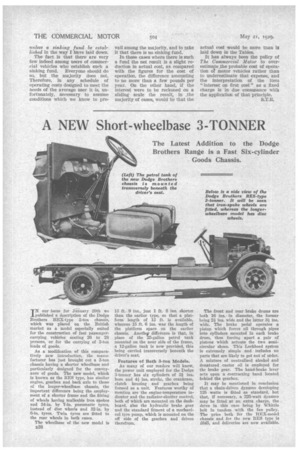COSTS Correcting Some Confused Ideas
Page 63

Page 64

If you've noticed an error in this article please click here to report it so we can fix it.
Explaining How Certain Readers and Users Have Fallen into the Error of Imagining the Item "Interest on First Cost" to be Diminishing.
ASUDDEN and violent storm b,as arisen over my interpretation of the item "interest on first cost" as it appears in The Commercial Motor Tables of Operating Costs. " Sudden " is, perhaps, hardly the word, in a way, since it has taken over 20 years for this storm to come about. I am told that the amount concerned dienishes, varying hi proportion to the value of the vehicle itself as it grows less from year to year. I disagree and, on the contrary, am taking this opportunity for confirming and emphasizing the fact that the amount of interest on capital expenditure is invariable, except that it alters in sympathy with the bank rate.
Methods of Assessment which are Wrong.
At the same time, I intend to go more than half-way to meet those who differ from me on this point, for I admit that they are correct in the results achieved by their methods and only wrong in the Interpretation of their accounts.
They are right in the belief that the incidence of the interest on first cost diminishes as the vehicle depreciates, but they are wrong in giving the credit to that item alone.
The incidence, but not the amount, of tire interest diminishes. The effect --the incidence of interest on capital outlay—may become less if, during the life of the vehicle, a sinking fund be established, a fund growing exactly in proportion to' the falling value of the vehicle, If that money be invested, at a rate of interest corresponding to that at which the interest on capital expenditure is calculated, then, as the fund grows, the interest on it, set against the interest on first cost, has the effect of diminishing the total liability and the result is the same as if we were merely to take it that the latter item automatically diminished, making no consideration of the interest on the sinking fund.
The procedure is fairly easy to understand and it may be illustrated by a simple example. Assume a vehicle costing £1,000 depreciated in such a manner as to lead the user to the conclusion that its life was going to be 160,000 miles. Let us take it that the machine covers 20,000 miles per year, on the average, which means that it will depreciate at the rate of 12i per cent. At the present time, interest on first cost is calculated at 6 per cent.-1 per cent, above bank rate. On the sum of £1,000 that is equivalent to £65 per year. It persists at
that figure throughout the life of the vehicle and, if it be not extinguished in any way, it extends beyond that period.
If a sinking fund be established, then, at the end of the first year, that fund will stand at £125, which during the ensuing year, will earn interest at the rate of 6i per cent. The return from that investment will -be £8 2s. 6d., and that sum may be offset against the £65 interest on first cost, so that the latter will be reduced, to all intents and purposes, to £56 17s. 6d.
At the end of the second year the sinking fund has risen to £250 and during the third year the interest on the fund will be £16 5s. and the effect of the interest on first cost will accordingly be diminished to £48 15s., and so on year by year.
The result of this method of operation is shown in the accompanying graph. Where the procedure of establishing a sinking fund in this manner is followed, and if it be desired, for accountancy purposes, to write down the interest on first cost in proportion as the interest on the sinking fund grows, it is better to establish an average figure for the interest on first cost based on that policy rather than to attempt to depreciate the amount year by year. To that end the following formula may be used :—
unless a sinking fund be established in the way .1 have laid down.
The fact is that there are very few indeed among users of commercial vehicles who establish such a sinking fund. Everyone should do so, but the majority does not. Therefore, in any schedule of operating costs designed to meet the needs of the average user it is, unfortunately, necessary to assume conditions which we know to pre
vail among the majority, and to take it that there is no sinking fund.
In those cases where there is such a fund the net result is a slight reduction in actual cost, as compared with the figures for the cost of operation, the difference amounting to no more than a few pounds per year. On the other hand, if the interest were to be reckoned on a sliding scale the result, in ,the majority of cases, would be that the
actual cost would be more than is laid down in the Tables.
It has always been the policy of The Commercial Motor to overestimate,the probable cost of operation or motor vehicles rather than to underestimate that expense, and the interpretation of the item .' interest on first cost" as a fixed charge is in due consonance with the application of that principle.




















































































































